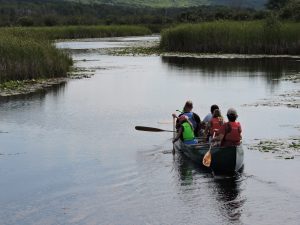The Six Reasons People Visit Your Nature Center
Dr. John Falk of Oregon State University has researched and written extensively about what motivates people to visit museums. His research applies to nature centers as well. If you aren’t familiar with his work and are in the nature center business, it’s overdue for you to put one of his books on your reading list. (I’d suggest Thriving in the Knowledge Age: New Business Models for Museums and Other Cultural Institutions, written with Beverly K. Sheppard.)
Here is my synopsis of his main points, though—and I hope he forgives any misrepresentation I inflict on his work. Falk says that, when people visit a museum or similar institution, they are driven by one of five motivations. (I add a sixth for nature centers. Keep reading.) They may have different motivations on different visits, he says, but during any one visit one motivation will predominate. Though they are fluid, you can think of these as “visitor types.” Using his names but my explanations, those types are:
- The Explorer. Driven by a broad curiosity, Explorers have lots of questions, read stuff, and in general approach their visit with an open-mindedness that their name implies. Often, in my experience, they are first-time visitors to your site.
- The Facilitator. A Facilitator brings other people to your center, and is mostly concerned that those guests have a good experience there—“good experience” as defined by the Facilitator. Facilitators can include grandparents with children, teachers with students, locals with out-of-town company, and even kids who have visited in the past with a school class and return with parents in tow.
- The Professional/Hobbyist. This is the visitor who knows more about some aspect of your site than you do. At nature centers, they are often birders or botanists or wildlife photographers. Like Explorers, they ask questions—but unusual questions. I am a Professional/Hobbyist when I visit your site. “How many square feet is this building? Which company did your exhibits? What percent of your electric bill is offset by your solar panels?”
- The Experience Seeker. You’ve seen these people on Instagram and Facebook, snapping selfies in front of Rodin’s The Thinker to show that they have been there. They visit certain places because “you’re supposed to.” Think of them as collectors of experiences. I believe they are rare at nature centers, because—unlike some of the more famous museums—most nature centers are not iconic enough to make the “must see” list.
- The Spiritual Seeker. The Spiritual Seeker comes to your site because it’s good for their soul. Your center is an island of calm in their lives, a place to step out of the rat race for a while and reflect. There are a few of them in art museums, wandering among the Impressionists on their lunch hour. There are lots of them at nature centers, walking the trails and sitting on the benches.

At nature centers, I have encountered one more visitor type out on the trails and boardwalks that Falk doesn’t mention. It includes the local high school cross-country team practicing for their next meet, power walkers trying to beat their best time on your three-mile loop, and a few others. I think of this type as the Exerciser. Many people who run or snowshoe on your trails are Spiritual Seekers, choosing to use your trails rather than the streets and sidewalks of their subdivision because of the natural setting. Some, though, are clearly focused on the workout. Those are the Exercisers.
Now, why does this analysis matter? It matters because, if you want to create satisfied customers who get the most possible from their nature center experience, you need to cater to their needs. Falk has some suggestions about how to do that. I’ll touch on those, and add some of my own, in my next post.
